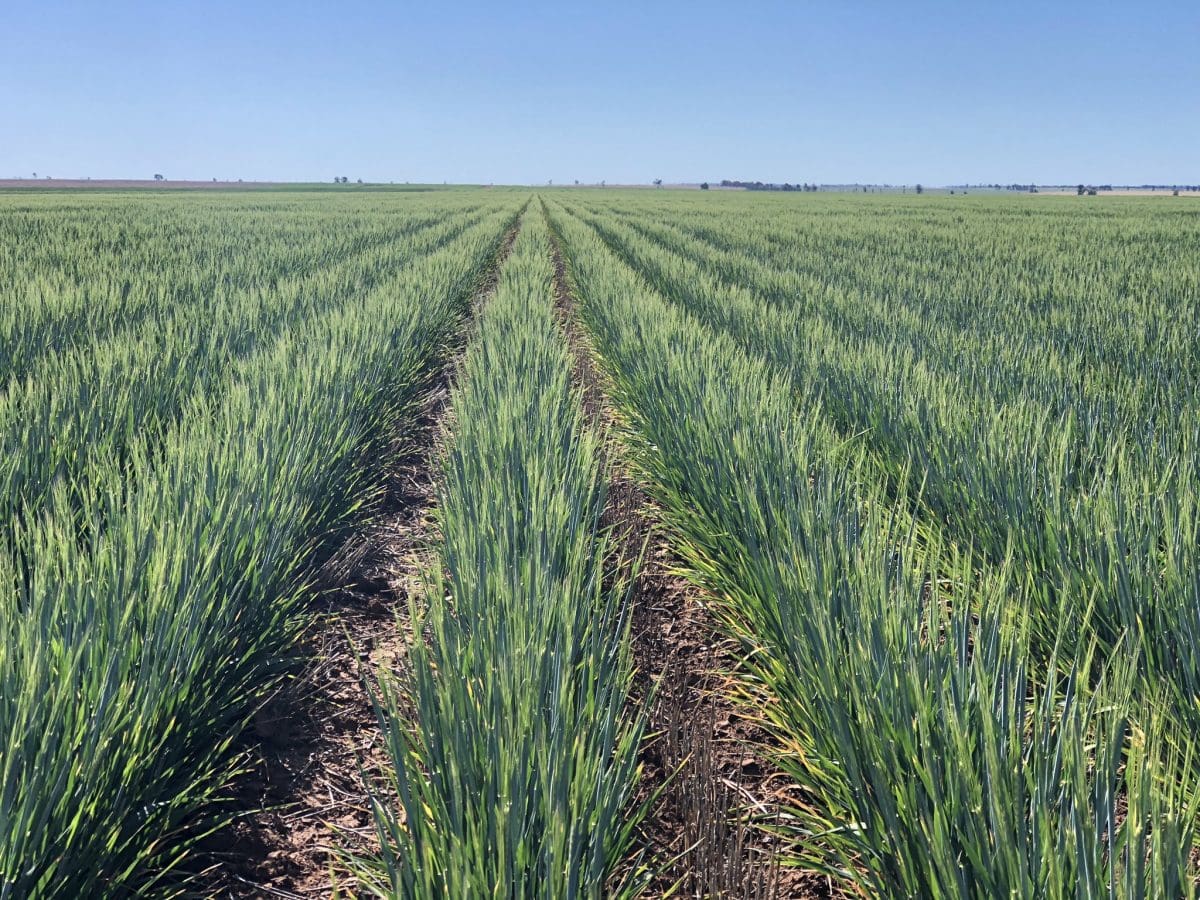
This April-planted crop of barley is among the most advanced of Queensland’s feedgrain crops. Photo: Stephen Gibson
THE READY supply of transshipped barley out of Brisbane is drying up, and has boosted nearby demand for grain out of northern Victoria.
This has lifted barley values by up to $15 per tonne in the past week, as forward volumes from the free-on-truck (FOT) market from port sites thin.
Further helping to support prices for current-crop wheat and barley has been a lack of grower selling.
In the sorghum market, reduced near-term demand has allowed values to soften.
| This week | Last week | Change | |
| Barley Downs July | $345 | $340-$345 | Firmer |
| Barley Downs Jan | $265 | $265 | Steady |
| Barley Melbourne July | $265 | $250 | Up |
| Barley Melbourne Jan | $245 | $230 | Up |
| Wheat Downs July | $397 | $395 | Up |
| Wheat Downs Jan | $292 | $300 | Down |
| Wheat Melbourne August | $340 | $340 | Steady |
| Wheat Melbourne Jan | $285 | $286 | Steady |
| Sorghum Downs July | $330 | $340 | Down |
| Sorghum Downs Mar-Apr | $270 | $275 | Down |
Table 1: Indicative delivered grain prices in AUD per tonne.
Barley finds support
At least two cargoes of Australian barley to China have appeared on shipping stems in the past week or two.
Trade sources have told Grain Central they did not indicate a return to normal sales of Australian barley into China, but were booked earlier to malting buyers operating in China’s free trade zones under tariff exemptions.
The execution of any malting barley cargoes to China will help to keep supply-side pressure off the current-crop barley complex in Australia.
Unsold stocks of barley in New South Wales, South Australia and Victoria are thought to be minimal, and consumers as far north as the Western Downs of southern Queensland are buying what they can via the trade out of Victoria.
With reduced numbers of cattle on feed, and further cuts likely, Downs consumers appear to be happy to buy direct from Victoria rather than build up stocks from the FOT market going into the new-crop inverse.
“Things have slowed right down when it comes to the number of boats coming around,” one trade source said.
“No-one will want any grain on the ground come October, and October’s not that far away.”
“Barley in Victoria seems to be supported by northern sites, and they are working by road freight back on to the Downs,” a trader said.
“Nobody’s going to put a vessel into Brisbane unsold, so consumers have got to find grain elsewhere.”
“There’s no reason for the trade or the consumer to take on risk by building up a big position,” another trader said.
After dipping late last week, the nearby Downs barley market has regained a few dollars, and is trading in small parcels.
“There’s not much grower selling.”
SA values flat, lower
At Rural Directions in South Australia, director Chris Heinjus said he thought unsold current-crop farmer stocks were close to exhausted.
Mr Heinjus said northern reaches of the SA grainbelt including the Upper Eyre Peninsula and Upper North had been getting less rain than southern regions, and crops across the state in general were well past emergence and into tillering.
“Lower latitudes are doing well with rain coming in on fronts.”
While delivered SA port wheat values for new-crop have been dropping $1/t a day over recent days, Mr Heinjus said barley was trading sideways, with wheat now at $275/t, and barley $215-$220/t.
“Saudi is the base, plus $5-$10, and growers are not engaging,” Mr Heinjus said.
Mr Heinjus said anecdotal evidence says SA growers may have dropped 5-10 per cent of their intended barley area in response to news at planting time about China’s tariffs on Australian barley.
Across Australia, this seems to be mildly supportive of barley values.
“No-one knows what’s not sown to barley.”
Sorghum slips
A slow and wet sorghum harvest in southern Queensland has reduced supply to a market exhibiting minimal demand.
“There’s a lot of wet sorghum in southern Queensland, and it will take a long time to dry.”
Along with poultry farms and piggeries, Dalby Bio-refinery is a major user of sorghum, and is now believed to be closed until August at the earliest.
Some sorghum is being packed into containers for export, but central Queensland does not appear to have the volume and quality needed to supply bulk exports from the crop now being harvested.
Cottonseed illiquid
Cottonseed markets remain somewhat illiquid, with current-crop values showing a weaker tone, and new-crop prices steady.
Woodside Commodities managing director Hamish Steele-Park said a large inverse still exists between new-crop and current-crop.
“The high price of old-crop is doing a good job of rationing demand,” he said.
“New-crop is well priced to buy demand as being competitive versus grains and other meals.”
In the July-August nearby market, seed ex gin is quoted at $550/t in Moree, $540/t in the Namoi Valley 540, and $515/t in southern NSW.
On new-crop, gin-spread values are Moree $300/t, Namoi Valley $285/t, southern NSW $295/t and Macquarie Valley $295/t.
The delivered Downs market in southern Queensland is now sitting at around $355 for May-December 2021.
Grain Central: Get our free daily cropping news straight to your inbox – Click here

HAVE YOUR SAY